肺癌课件英文
- 格式:pptx
- 大小:10.84 MB
- 文档页数:127
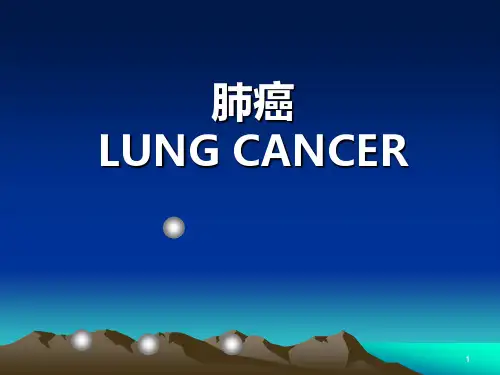
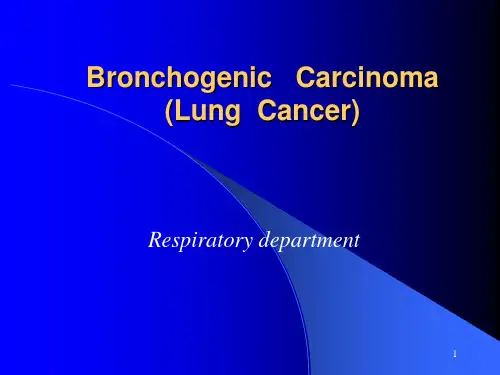



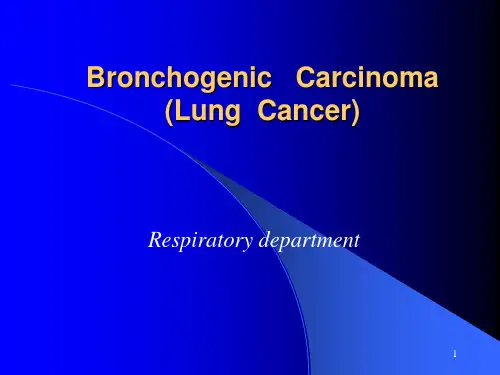
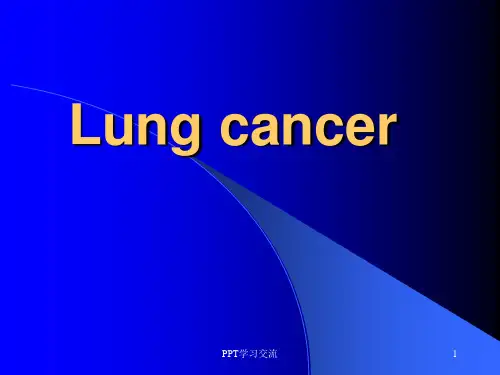

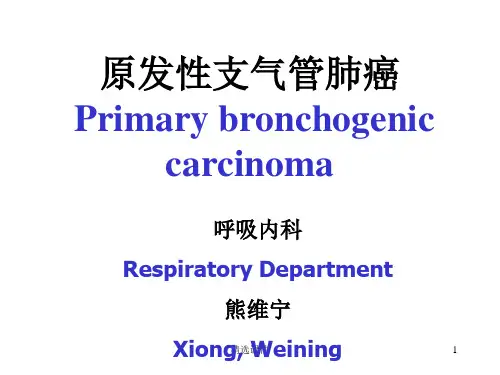

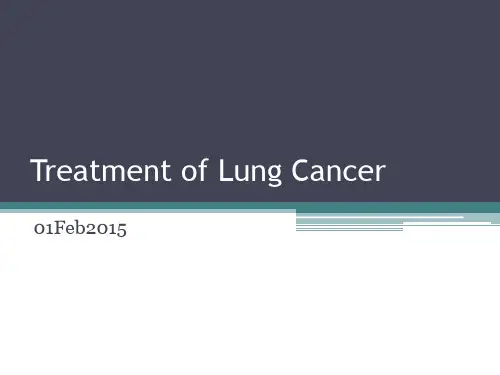
Lung Cancer 101 and ASCO 2016 HighlightsDr. Jennifer Garst with ASCO slides by Dr. Jared WeissDuke Cancer Institute at Duke Cancer Center Raleigh8/20/2016Build Hope. Take Action.End Lung Cancer.Mission…..To save lives and provide support to thoseaffected by lung cancer through research,awareness, education, and access programsacross North Carolina.A Major Public Health Problem•Estimated 1.6 million deaths each year worldwide from lung cancer •In 2015:–Estimated 221,200 new cases of lung cancer expected to be diagnosed in US –158,000 Americans expected to die from lung cancer•Leading cause of cancer-related deaths in US men and women –More deaths from lung cancer than breast, prostate, colon, liver, melanoma, and kidney cancers combined•Need for better thought out, patient-driven studiesTorre LA, et al. CA Cancer J Clin. 2015;65(2):87-108.Siegel RL, et al. CA Cancer J Clin. 2015;65(1):5-29.USA DistributionWhat is lung cancer?Lung cancer is an uncontrolled growth ofabnormal cells that starts in the lungs.Cancer can develop with a mutation or error inthe lung cell’s DNA.DNA mutations can be caused by the normalaging process and through exposure to toxins like smoke, viruses, radon, and otherenvironmental factors. Cigarette SmokeLung Cancer Risk Factors•Current or past H/O smoking or second handsmoke exposure•Radon exposure•Previous cancer•Lung disease, COPD, pulmonary fibrosis •Toxic exposures: arsenic, chromium, asbestos, nickel,, cadmium, beryllium, silica, dieselfumes, viruses•Genetic risksWhat is lung cancer?It likely takes a series of mutations to create alung cancer cell. Cells may be pre-cancerous due to some mutations but continue to function like normal lung cells. As these cells divide, the mutations are passed down and can become augmented from other toxic exposures until the cells do not behave like normal lung cells andtake on the characteristics or “hallmarks” ofcancer.Hanahan D, et al. Cell . 2000;100(1):57-70. Self-sufficiencyin growth signalsEvading apoptosis Sustained angiogenesis Limitless replicativepotentialInsensitivity toantigrowth signalsTissueinvasion andmetastasisThe Hallmarks of Cancer: New Targets•228,190 new cases of lung cancer •159,480 deaths dueto lung cancer MenLung and bronchus 28%Prostate 10%Colon and rectum 9%Pancreas 6%Leukemia 5%WomenLung and bronchus 26% Breast 14% Colon and rectum 9%Pancreas 7%Ovary 5%Leading Sites, United States, 2013 EstimatesSiegel R, et al. CA Cancer J Clin . 2013;63(1):11-30.Cancer-Related DeathsCommon causesof US cancerdeaths, 2008 Rudin CM, et al. Clin Cancer Res.2009;15(18):5622-5625. Ever-SmokersNever-SmokersTypes of Lung Cancer •Non-Small Cell Lung Cancer –AdenocarcinomaSquamous cell carcinoma–Large cell•Small Cell Lung CancerNSCLC Stages at PresentationSubramanian J, et al. J Thorac Oncol. 2010;5: 23–28.Staging: NSCLCStage I:•≤ 5cm; no lymph nodes involvedStage II:•≤ 7cm, if ipsilateral hilar lymphnodes involved•>7cm, or local invasion, ormultiple nodules in same lobe ifno lymph nodes involvedStaging: NSCLCStage III:•Has not spread beyond lymphnodes in chest•May have metastases withinipsilateral lung•May have local invasion of majorstructuresStage IV:•Metastatic disease or disease withpleural effusionLess Invasive Lung Cancer Staging EndoBronchial Ultrasound (EBUS) Mediastinoscopy Use of an ultrasound-guided camera to biopsy lymph nodes around the airway with needle aspirationSurgical removal of lymph nodes from around the main airway ENDOBRONCHIAL ULTRASOUND EBUS is done under general anesthesia Angled, balloon-tipped ultrasoundbronchoscopeallowssimultaneousendoscopic andultrasound views Endoscopic viewUltrasound viewEBUS probe in the main airwayCurrent State of NSCLC •NSCLC: ~ 85% of lung cancers•Histology-directed therapy–Non-squamous: bevacizumab, pemetrexed–Squamous: nab-paclitaxel, nivolumab•Biomarker-directed therapy–Erlotinib, afatinib, gefitinib, crizotinib, ceritinib •Immunotherapy•Overcoming resistance–EGFR and ALK resistanceMore Choices = More Decisionspatients, providers, payersStrategies to ImproveOutcome of Lung Cancer Patients •Move away from approaching lung cancer as one disease•Develop treatment strategies for different subsets of lung cancer•Treatment improvements based on–Histology–Oncogenic alterations–ProteomicsFirst-line Second-line Third-line Maintenance Not approved 1970 1980 1990 2000 MedianOS (mos) 12+ ~ 6~ 2–4 BSC Single-agent platinum DoubletsBevacizumab + PC Carboplatin a1989 ErlotinibPemetrexed2004Docetaxel1999 PaclitaxelGemcitabine 1998 Vinorelbine 1994 Docetaxel 2002 Bevacizumab2006Gefitinib2003Standard Therapies a Label does not include NSCLC-specific indication. BSC = best supportive care;PC = paclitaxel/carboplatin; OS = overall survival. Adapted from Shrump, et al. Non-small cell lung cancer. In: Cancer: Principles and Practice of Oncology . 7th ed.Philadelphia, PA: Lippincott Williams & Wilkins:2005.Pemetrexed2008/2009Histology-directed therapyCisplatin a 1978History of Therapy in Advanced NSCLC: FDAApproval Dates 1970-20102010Erlotinib2010 ~ 8–10Maintenance Therapy Targeted TherapyALK TranslocationEGFR Mutation2011 2013History of Therapy in Advanced NSCLC: FDAApproval Dates 2011-2013Crizotinib 2011 Erlotinib 2013 Afatinib 2013MedianOS(mos)Targeted Therapy20-30+ monthsLung Cancer Mutation Consortium: Incidence ofDriver MutationsROS-1 1%Kris MG, et al. JAMA. 2014;311:1998-2006.Lung Adenocarcinoma MutationsRudin CM, et al. Clin Cancer Res. 2009;15(18):5646-5661.MATCH trial EGFR SignalingAdapted from Ciardiello F, Tortora G. N Engl J Med. 2008;358:1160-1174. gefitinib erlotinibEGFR MUT Disease Progressionon an EGFR TKI Molecular: •Unknown (other pathways) •EGFR T790M (exon 20) •MET amplification •PIK3CA •SCLC Clinical PD appearance: •Rapid disease PD globally •Slow growth globally •Growth in several areas, but not all T790M~ 40-55% T790M +EGFR amp~ 10% Other EGFR mut 1-2%SCLC w/PI3K ~ 4% SCLC~ 6% PIK3CA~ 1-2%MET amp~ 5% BRAF ~ 1%HER2 Amp ~ 8-13%EMT~ 1-2%Unknown~ 15-20%Camidge DR, et al. Nat Rev Clin Oncol. 2014;11(8):473-481.Osimertinib activity in patients with leptomeningeal disease from non-small cell lung cancer: <br />updated results from the BLOOM studyPresented By James Yang at 2016 ASCO Annual MeetingChanges in EGFRm DNA copy number in CSF <br />with osimertinib treatmentPresented By James Yang at 2016 ASCO Annual MeetingPhase I study (BLOOM) of AZD3759, a CNS penetrable EGFR inhibitor, for the treatment of non-small-cell lung cancer (NSCLC) with brain metastasis (BM) and leptomeningeal metastasis (LM)Presented By Myung-Ju Ahn at 2016 ASCO Annual MeetingThird Generation EGFR TKIs“3rd” Generation N RR* T790M- RR T790M+PFS ToxicityRociletinib (CO-1686)256 37% 53% ~ 8.0 mo Hyperglycemia AZD9291 253 21% 61% ~ 8.2 mo Diarrhea HM61713 (800 mg) 62 12% (300 mg)55% NR Dyspnea/rash EGF816X* 53 - 60% NR RashASP8273* 47 ~ 33% 61% NR Hyponatremia/diarrheaSequist L, et al. J Clin Oncol. 2015;33(suppl). Abstract 8001; Jänne PA, et al. N Engl J Med. 2015;372(18):1689-1699; Park K, et al. J Clin Oncol. 2015;33(suppl). Abstract 8084; Tan DS-W, et al. J Clin Oncol. 2015;33(suppl). Abstract 8013; Goto Y , et al. J Clin Oncol. 2015;33(suppl). Abstract 8014.Multiple other agents earlier in development*T790M - subgroups are very small. RR, response rate; PFS, progression-free survival.ALK Fusion Oncogenes and Downstream Signaling Shaw AT, Solomon B. Clin Cancer Re s. 2011;17:2081-2086.Alectinib versus Crizotinib in ALK Inhibitor Naïve ALK-Positive Non-Small Cell Lung Cancer:<br /> Primary Results from the J-ALEX StudyPresented By Hiroshi Nokihara at 2016 ASCO Annual Meeting J-ALEX Phase III Study DesignPresented By Hiroshi Nokihara at 2016 ASCO Annual MeetingPrimary Endpoint: PFS by IRF (ITT Population)Presented By Hiroshi Nokihara at 2016 ASCO Annual MeetingBrigatinib in Patients With Crizotinib-Refractory ALK+ Non–Small Cell Lung Cancer: First Report of Efficacy and Safety From a Pivotal Randomized Phase 2 Trial (ALTA)Presented By Dong-Wan Kim at 2016 ASCO Annual MeetingPFS by ArmPresented By Dong-Wan Kim at 2016 ASCO Annual Meeting Survival by ArmPresented By Dong-Wan Kim at 2016 ASCO Annual MeetingROS1 Rearrangement in Lung CancerJänne PA, et al. J Clin Oncol. 2012;30(8):878-879.Safety and Efficacy of Lorlatinib (PF-06463922) From the Dose Escalation Component of a Study in Patients With Advanced ALK+ or ROS1+ Non-Small-Cell Lung CancerPresented By Benjamin Solomon at 2016 ASCO Annual MeetingPhase I Design and Patient Population <br />of an Ongoing Phase I/II StudyPresented By Benjamin Solomon at 2016 ASCO Annual Meeting Clinical Activity: <br />Progression-Free Survival in ALK+ PatientsPresented By Benjamin Solomon at 2016 ASCO Annual MeetingMajority of ROS1 Patients Had a <br />Decrease in Target Lesion Size*Presented By Benjamin Solomon at 2016 ASCO Annual Meeting CNS Responses in ALK/ROS1+ Patients<br />with Measurable DiseasePresented By Benjamin Solomon at 2016 ASCO Annual MeetingOther Drugs That Target ALK and/or ROS-1 •1st-generation ALKCrizotinib( plus ROS-1)•2nd-generation ALK Inhibitors‒Ceritinib (LDK378)( plus ROS-1)‒ Alectinib (CH5424802)( no ROS-1 activity)•ALK/EGFR/ROS-1 Inhibitors‒Brigatinib (AP26113)(nearing approval process)Promising Others ALK/ROS-1: Lorlatinib, Ensartinib (X-396)in clinical trialsResistance: Cabozantinib (FDA approved medthyroid/renal), TPX-0005 (ALK/SRC) in clinical trialsResponse of An ROS1+ PatientBaseline 12 Weeks Crizotinib Bergethon K, et al. J Clin Oncol. 2012;30(8):863-870.Antitumor Activity and Safety of Crizotinib <br />in Patients with Advanced MET Exon 14-Altered <br />Non-Small Cell Lung CancerPresented By Alexander Drilon at 2016 ASCO Annual Meeting Slide 11Presented By Alexander Drilon at 2016 ASCO Annual MeetingAn Open-Label Phase 2 Trial of Dabrafenib in Combination With Trametinib in Patients With Previously Treated BRAF V600E–Mutant Advanced <br />Non-Small Cell Lung Cancer (BRF113928)Presented By David Planchard at 2016 ASCO Annual MeetingProgression-Free SurvivalPresented By David Planchard at 2016 ASCO Annual MeetingSlide 1Presented By D. Camidge at 2016 ASCO Annual Meeting Antibody Drug Conjugate: Sacituzumab Govitecan (IMMU-132)Presented By D. Camidge at 2016 ASCO Annual MeetingProgression-Free Survival and Overall Survival <br />(8 or 10 mg/kg; median of 3 prior therapies)Presented By D. Camidge at 2016 ASCO Annual MeetingImmunotherapy in NSCLC•Immunotherapy•Vaccines•Check-point inhibitors:•Preliminary evidence of activity with CTLA-4 andchemotherapy•Preliminary evidence of activity with PD-1 or PD-L1Lynch TJ, et al. J Clin Oncol. 2012. Genova C, et al. Expert Opin Biol Ther 2012. Brahmer JR et al NEJM 2012, Topalian S et al NEJM 2012PD-1, PD-L1 AntibodiesTarget AgentPD-1 Nivolumab (BMS-936558)Pembrolizumab (MK-3475)Pidilizumab (CT-011)AMP-224PD-L1 BMS-936559Durvalumab (MEDI4736)Atezolizumab (MPDL-3280A)PD-1, programmed death receptor-1; PD-L1, programmed death-ligand 1.Davies M. Cancer Manag Res. 2014;6:63-75; Brahmer JR. J Clin Oncol. 2013;31(8):1021-1028; Rizvi NA, et al. J Clin Oncol. 2014;32(suppl 15). Abstract 8007;Brahmer JR, et al. J Clin Oncol. 2014;32(suppl 15). Abstract 8021.CheckMate 012: Safety and Efficacy of First‐line Nivolumab and Ipilimumab in Advanced NSCLCPresented By Matthew Hellmann at 2016 ASCO Annual MeetingNivolumab Plus Ipilimumab in First-line NSCLC:<br />Summary of EfficacyPresented By Matthew Hellmann at 2016 ASCO Annual Meeting Nivolumab Plus Ipilimumab in First-line NSCLC:<br />Efficacy Across All Tumor PD-L1 Expression LevelsPresented By Matthew Hellmann at 2016 ASCO Annual Meeting•Immune responses are dynamic and evolve. •A single biomarker may not be the complete answer.•“Mutational Load” is a very important factor and may be a better predictor of response to a single PD-1 blockade.•Micro-environment influences responses to PD-1 blockade …....hypoxia, metabolism, genetics.ImmunotherapyConclusions:Small cell lung cancerSafety and efficacy of single agent rovalpituzumab tesirine (SC16LD6.5), a delta-like protein 3 (DLL3)-targeted antibody-drug conjugate (ADC) in recurrent or refractory small cell lung cancer (SCLC)Presented By Charles Rudin at 2016 ASCO Annual MeetingSCLC Kaplan-Meier Overall SurvivalPresented By Charles Rudin at 2016 ASCO Annual Meeting Favorable Comparison vs. Existing 2L and 3L CTXPresented By Charles Rudin at 2016 ASCO Annual MeetingLocal Consolidative Therapy (LCT) Improves Progression-Free Survival (PFS) in Patients with Oligometastatic Non-Small Cell Lung Cancer (NSCLC) who do not Progress after Front Line Systemic Therapy (FLST): Results of a Multi-Institutional Phase II Randomized StudyPresented By Daniel Gomez at 2016 ASCO Annual MeetingTrial DesignPresented By Daniel Gomez at 2016 ASCO Annual MeetingTrial DesignPresented By Daniel Gomez at 2016 ASCO Annual Meeting Prognostic Factors for PFSPresented By Daniel Gomez at 2016 ASCO Annual MeetingImproved Overall Survival in Lung Cancer Patients <br />using a Webapplication-mediated Follow-up compared to Standard Modalities: <br />Results of a Phase III Randomized TrialPresented By Fabrice Denis at 2016 ASCO Annual MeetingPhase 3 multi-centric randomized studyPresented By Fabrice Denis at 2016 ASCO Annual MeetingOverall Survival ImprovementPresented By Fabrice Denis at 2016 ASCO Annual Meeting Other « intensive » clinical follow-up studiesPresented By Fabrice Denis at 2016 ASCO Annual MeetingChallenges for the Next Decade•Expanding biomarker-directed therapy –Transitioning to multiplex testing–BRAF, Exon 14 MET, HER2•Defining role of immunotherapy •Squamous histology-directed therapy •Small cell lung cancer•Maintenance ‒ what surrogate can we use?Figure 6Source: Cell , Volume 144, Issue 5, Pages 646-674 (DOI:10.1016/j.cell.2011.02.013)Copyright © 2011 Elsevier Inc. Terms and ConditionsTrends Continuing as Screening for Lung CA Evolves •Earlier Detection–NLST Results finding survival benefitwith CT screening•Earlier Diagnosis–Navigational Bronchoscopy•More Treatment Options–Early stage Lung CA improvedprognosis, more flexibility withtreatment options tailored to patientDuke Raleigh Hospital Cancer CenterMultidisciplinary Lung Cancer Care TeamStanding: Brenda Wilcox , RN; Dr. Jennifer Garst; Lisa Dowd, NP; Dr. Albert Chang Seated: Dr. Catherine Chang, Dr. David White, Katherine Gillis, PA-CRadiation FieldsReferral: Fast andAppropriate•Medical oncologists – appropriate for every lung cancer patient•Thoracic surgeons – role intreatment for all stage patients–Best results from centers that do highernumber of thoracic surgeriesClinical Trials: The Road to New Therapeutic Advances •With the advances being made in lung cancer treatment, clinical trials are an attractivetherapy option•The family physician is often the most trusted – your advice carries a lot of weight!•You don’t need to know that there is a trial available, just plant the seed!Trends in Management of Lung CA HOPE Image GuidanceLess invasiveBetter OutcomesTargeted Therapy Earlier DetectionTeam HOPE•We all need a team of support: •Family and friends•Advocacy groups like LCI•Social media/blogs/ carebridges •Local medical team•Consulting medical team •Spiritual support and more…...Our “A” team: Jonathan Choe, PA-C, Vereterrica Rushdan, RMA, Jennifer Mizelle, RN, Elattmont Spiller, patient care coordinatorHeather Hooper, Executive Director Thank You to Our Staff!Lynne Ritter,Director of FinanceKhaki Stelten, Communications & Development Manager Jenni Danai Programs Manager Parker Shields Administrative & Program AssistantCynamon Frierson, Communication & Marketing ManagerWe are very much looking forward to partnering with you in the cause and making lung cancer awareness andresearch a priority.Together, there ’s always somethingwe can do!。